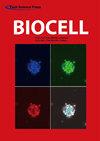BTLA在肿瘤中的生物学功能及临床价值的泛癌分析
IF 1
4区 生物学
Q4 BIOLOGY
引用次数: 1
摘要
B和t淋巴细胞衰减剂(BTLA)通过抑制t和B细胞功能发挥免疫抑制作用。BTLA与多种疾病有关,特别是与癌症免疫有关。然而,BTLA在各种肿瘤中的作用及其临床预后价值尚未得到全面分析。本研究旨在从BTLA在各种肿瘤中的表达差异、临床价值、免疫浸润及与免疫相关基因的相关性等方面探讨BTLA与肿瘤的关系。从TCGA数据库中收集33例现有肿瘤患者的mRNA表达、miRNA表达、lncRNA表达及临床资料。BTLA的靶miRNA和与靶miRNA相互作用的lncRNA从StarBase数据库中获得。基于生物信息学分析方法,深入研究了不同类型肿瘤与BTLA的关系,构建了BTLA、靶miRNA和相互作用lncRNA相互竞争的内源RNA网络。使用KM绘图仪完成各种类型癌症中BTLA和靶miRNA (has-miR-137)的Kaplan-Meier (KM)预后分析。BTLA在不同肿瘤中的表达存在差异,在9种肿瘤类型中表达差异均有统计学意义。KM绘图仪分析肿瘤患者的总生存期(OS)和无回归生存预后结果显示,21种肿瘤中有11种肿瘤的OS中BTLA表达有统计学差异;8种癌症的OS也有统计学差异。肿瘤免疫基因相关性分析显示BTLA表达与免疫抑制基因(CTLA4和PDCD1)表达呈正相关。基因集富集分析表明,BTLA及其共表达基因主要通过免疫应答调节、细胞表面受体信号通路、抗原结合、抗原受体介导的信号通路、白细胞迁移等生物学过程和途径发挥作用。BTLA有潜力作为CLL、COAD、NSCLC和OV的预后标志物,以及CLL、COAD和KIRC的诊断标志物。BTLA与肿瘤的发生发展有着密切而复杂的关系,针对BTLA的肿瘤免疫治疗值得进一步分析。本文章由计算机程序翻译,如有差异,请以英文原文为准。
A pan-cancer analysis of the biological function and clinical value of BTLA in tumors
B and T-lymphocyte attenuator (BTLA) plays an immunosuppressive role by inhibiting Tand B-cell functions. BTLA is associated with a variety of diseases, especially cancer immunity. However, the function of BTLA in various cancers and its clinical prognostic value have still not been comprehensively analyzed. This study aimed to identify the relationship between BTLA and cancer from the perspectives of differences in BTLA expression, its clinical value, immune infiltration, and the correlation with immune-related genes in various cancers. Data regarding mRNA expression, miRNA expression, lncRNA expression, and clinical data of patients of 33 existing cancers were collected from the TCGA database. Target miRNA of BTLA and the lncRNA that interacts with the target miRNA were obtained from the StarBase database. Based on bioinformatics analysis methods, the relationship between various types of cancers and BTLA was thoroughly investigated, and a competing endogenous RNA network of BTLA, target miRNA, and interacting lncRNA was constructed. The Kaplan-Meier (KM) prognostic analysis of BTLA and target miRNA (has-miR-137) in various types of cancers was completed using the KM plotter. BTLA expression varied in different cancers, with statistical significance in nine cancer types. KM plotter to analyze the overall survival (OS) and regression-free survival prognosis of cancer patients revealed that the BTLA expression was statistically different in the OS of 11 types of cancers out of 21 types of cancers; the OS of 8 type of cancers was also statistically different. Correlation analysis of tumor immune genes revealed a positive correlation of BTLA expression with immunosuppressive gene (CTLA4 and PDCD1) expression. Gene Set Enrichment Analysis showed that BTLA and its co-expressed genes mainly act through biological processes and pathways, including immune response regulation, cell surface receptor signaling pathway, antigen binding, antigen receptor-mediated signaling pathway, and leukocyte migration. BTLA has the potential as a prognostic marker for CLL, COAD, NSCLC, and OV and a diagnostic marker for CLL, COAD, and KIRC. BTLA has a close and complex relationship with the occurrence and development of tumors, and cancer immunotherapy for BTLA is worthy of further analysis.
求助全文
通过发布文献求助,成功后即可免费获取论文全文。
去求助
来源期刊

Biocell
生物-生物学
CiteScore
1.50
自引率
16.70%
发文量
259
审稿时长
>12 weeks
期刊介绍:
BIOCELL welcomes Research articles and Review papers on structure, function and macromolecular organization of cells and cell components, focusing on cellular dynamics, motility and differentiation, particularly if related to cellular biochemistry, molecular biology, immunology, neurobiology, and on the suborganismal and organismal aspects of Vertebrate Reproduction and Development, Invertebrate Biology and Plant Biology.
 求助内容:
求助内容: 应助结果提醒方式:
应助结果提醒方式:


